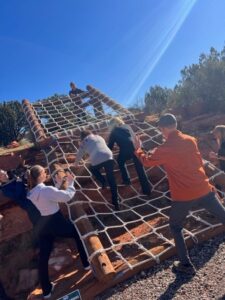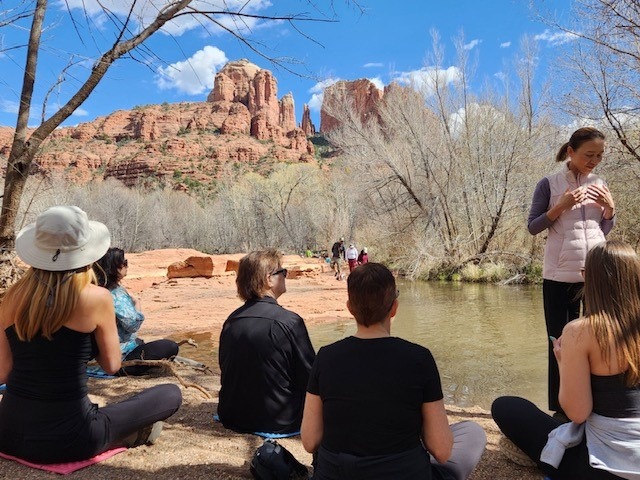Meeting professionals spend months and sometimes years designing events that are engaging, inspiring and educational. But once the custom tablecloths have gone back to the rental company and the stage deck has been struck, we are often slackers when it comes to deconstructing how it all went so we can improve the next time.
A recent visit to Sedona Mago Center for Well-being for a taste of Body & Brain Wellness experiences in Arizona was a reminder that as meeting professionals, we have to look holistically at how we treat our guests physically, challenge them mentally and support them spiritually. I came back with four essential questions to ask at the end of each program that could aid in making the next one better.
A Desert Wellness Oasis
 First, let’s set the scene. At the end of a 10-mile dirt road is a 173-acre campus set in the high desert of the red rocks of Sedona. The word “Mago” means unconditional love and spirit of Mother Earth in Korean and the campus is designed to connect visitors with themselves and their surroundings by offering access to walking trails, meditation sites and multiple labyrinths situated near identified “energy vortexes” and a man-made lake. Founder Ilchi Lee, a Tao master and author of “The Call of Sedona: Journey Of the Heart,” in addition to 40 other titles, discovered the property in 1997 after the previous retreat center went into foreclosure and brought it back to life as a wellness destination.
First, let’s set the scene. At the end of a 10-mile dirt road is a 173-acre campus set in the high desert of the red rocks of Sedona. The word “Mago” means unconditional love and spirit of Mother Earth in Korean and the campus is designed to connect visitors with themselves and their surroundings by offering access to walking trails, meditation sites and multiple labyrinths situated near identified “energy vortexes” and a man-made lake. Founder Ilchi Lee, a Tao master and author of “The Call of Sedona: Journey Of the Heart,” in addition to 40 other titles, discovered the property in 1997 after the previous retreat center went into foreclosure and brought it back to life as a wellness destination.
Read More: Waldorf Astoria Las Vegas Pilots Holistic Harmony Wellness Retreat
The property now includes 120 casitas and suites, 10 meeting rooms that can accommodate groups from 20 to 200 and 13 new outdoor team-building structures. Inclusive pricing covers meeting space, all audiovisual equipment and meals in the pescatarian kitchen (no meat, alcohol or tobacco is allowed on the property).
The guides on this journey were part of Body & Brain Wellness, one of the offerings included in the Caesars Entertainment Wellness Menu. The organization is headquartered in Phoenix, runs 80 centers in major U.S. cities and has a global presence in Korea, Japan, France, New Zealand and beyond. Body & Brain offers wellness enhancement programs for conferences in the form of speakers, classes, icebreakers and team-building exercises. That could look like tapping, deep-breathing exercises, guided meditation or DahnMuDo, a Korean version of Tai Chi that translates to “the way of limitless energy.”
“We are bringing stress management and collective awareness training to the corporate world because people spend so much time there. If they learned a better way to interact, it could have a big impact,” said Dami Kim, director of Body & Brain Wellness.
Read More: Retreat to the Great Smokey Mountains
A Guided Group Perspective
 One piece of the group mind-body puzzle was an immersive team-building experience. While the physical challenges built into the scenic landscape looked like many traditional ropes courses, the takeaways went deeper than climbing a pole. Whether navigating a Bungie “spider web”, coordinating a six-person ski walk, climbing a net tied to another person or balancing on a platform, everyone in the group was engaged by Body & Brain Wellness Executive Coach Steve Kim (no relation to Dami Kim).
One piece of the group mind-body puzzle was an immersive team-building experience. While the physical challenges built into the scenic landscape looked like many traditional ropes courses, the takeaways went deeper than climbing a pole. Whether navigating a Bungie “spider web”, coordinating a six-person ski walk, climbing a net tied to another person or balancing on a platform, everyone in the group was engaged by Body & Brain Wellness Executive Coach Steve Kim (no relation to Dami Kim).
“The secret is to reassess the team’s strengths and expand their true potential,” he said. Trust building, responsible risk-taking, problem-solving and goal achievement were the priority rather than mere completion. The exercises and immediate debriefs resulted in aha moments and lessons in seeking perspective from everyone.
The first order of business was learning how to ground the body for maximum strength to spot each other during the activities. The open stance, knees bent, one leg back, body square and arms extended worked as a human net in case of a fall and an attitude to catch alternative ideas.
Read More: Company Retreat Planning 101: 8 Elements for a Great One
An example of the evaluative approach came early in the day. Even though the group succeeded in getting everyone through a series of openings in a “web,” the post-exercise analysis on the other side revealed the importance of working with each person’s strengths, thinking through the implications of each decision and revealing new strategies for approaching the problem.
Similarly, when trying to balance the group on a platform, the planning process called for designating a leader, dividing people into sections based on size and developing hand signals since talking was not allowed. The reality of the experience was a more instinctual reaction on the part of each individual, not unlike how fish and birds move in unison.
“We often need to think less and feel more,” said Steve Kim. “Balance is not in your mind; it is in your body.”
Having a conversation when everyone is relaxed and comfortable at a cocktail party is a different experience than communicating in the moment when facing a challenge. Less is often more as the brain knows what to do and just needs clear prompting. Nonverbal challenges that rely on body language and shared history can strengthen trust and collaboration in teams better than any written procedures.
“The true source of DEI is empathy, not policymaking,” explained Dami Kim. When people identify with the experiences of those around them, differences become assets rather than blockades.
Read More: Why is DEI Critical to the Hospitality Industry?
The message was that everything we need to shine is present in ourselves. We just forget how powerful we are until we focus on being present. When the mind lives in the past and the future, that makes it harder to recognize our own greatness. “The secret is to harness collective awareness and spontaneous harmony to enable behavioral change for peak performance,” Steve Kim said.
4 Post-con Questions
By regrouping everyone involved immediately after an event, you can capture ideas while they are still fresh. Even a successful event can benefit from tweaks and iterations to minimize effort and enhance impact.
- What could have been done differently to make it smoother, more efficient or elegant?
- Was there another way to approach the event/agenda/goal?
- Was all communication clear, short and effective?
- Did we leverage the strengths of everyone involved or rely too much on a few skill sets?
Continue your journey with Dami Kim, as she and Ilchibuko Todd, CEO of Body & Brain Yoga & Health Centers Inc., discuss body and mind exercises that can help corporate groups be more productive.





